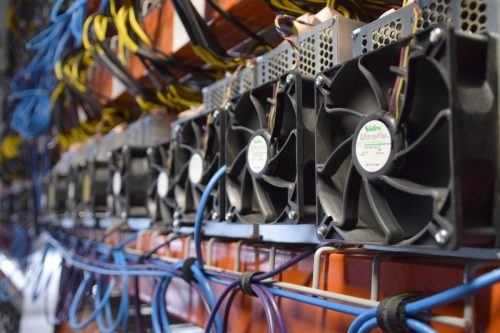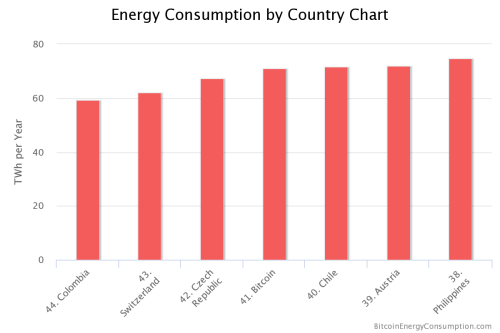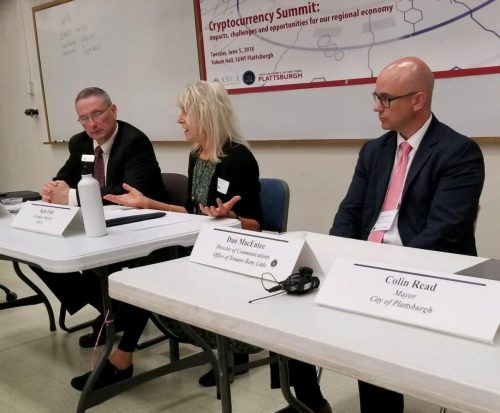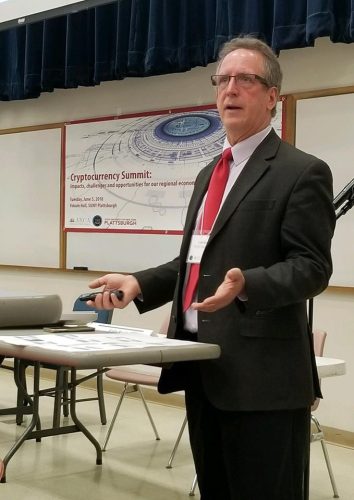Just when you thought you’d learned a whole new vocabulary (Uber, Airdrop, gig economy, mansplain, bloviate, co-sleeping, kombucha, glamping…) so you can communicate with your kids or understand the news, along comes another whole new vocabulary. Cryptocurrency, Blockchain, Bitcoin, Bitcoin miners, Ethereum, Nonce, Gigahash. Do you really need to learn these?
We think so. ANCA is focused single-mindedly on growing the New Economy up in the northern parts of the state. And we are digging into this issue and learning what these terms mean. We recently hosted the Cryptocurrency Summit at SUNY Plattsburgh. Here’s why.
Cryptocurrency mining uses a HUGE amount of energy, generates a lot of wasted heat and creates very few jobs. This kind of ‘mining’ requires banks of computers running complex algorithms 24/7 hoping to find the right number, called a nonce, that will release the next bitcoin. Because the energy cost of running these things is so high, cryptocurrency miners have come north, attracted by the low-cost electricity in some of our North Country communities and, in the process, have driven up the cost of electricity for residents and businesses. In response, some communities have put a moratorium on selling this low-cost power to miners until they have sorted out whether or how some benefit can accrue to the community. But a moratorium is just that. It’s a temporary halt until appropriate public policy and regulations are put in place, and that’s what we are focusing on.


Photo by David Sommerstein/NCPR: Crypto mining computers use a large amount of electricity and produce excess heat.
Graphic by BitcoinEnergyConsumption.com: Bitcoin mining energy use compared to that of countries around the world.
So what exactly is cryptocurrency? The New Yorker describes it in a recent article:
“Cryptocurrencies were a direct result of the 2008 crisis, when people lost faith in banks and bankers. Bitcoin was launched in 2009 as a peer-to-peer-based currency, which allowed users to carry out payment transactions without an intermediary, like a bank or a credit-card company, while maintaining anonymity.
Cryptocurrencies cannot be held or understood in any physical way; they have no central location. Fiat currencies such as the dollar are backed by both central governments and their users, but cryptocurrencies are almost always backed by nothing more than their users.”
It’s a highly volatile situation, and a handful of people have already gotten really really rich through mining and trading this commodity. The value of ONE Bitcoin went from $1,800 on May 18, 2017 to $19,000 on December 17, 2017. The price is currently around $6,434.
But here is maybe the most important thing as we think about how this begins to play a role in the New Economy. Blockchain. According to the Harvard Business Review, “The technology most likely to change the next decade of business is not the social web, big data, the cloud, robotics or even artificial intelligence. It’s the blockchain…” Oracle, a multinational computer technology company, says this about it: “Blockchain is one of today’s most disruptive emerging technologies.”
Harvard Business Review states: “Blockchain technology is complex, but the idea is simple. At its most basic, blockchain is a vast, global distributed ledger or database running on millions of devices and open to anyone, where not just information but anything of value – money, titles, deeds, music, art, scientific discoveries, intellectual property, and even votes – can be moved and stored securely and privately. On the blockchain, trust is established, not by powerful intermediaries like banks, governments and technology companies, but through mass collaboration and clever code. Blockchains ensure integrity and trust between strangers. They make it difficult to cheat.”
This disruptive aspect, and how it could apply to our activities in the North, along with how we ensure that communities benefit from hosting cryptocurrency miners, is what intrigues us. There are experiments exploring the use of blockchain in the energy sector, with renewable power being sold directly from producer to consumer. India is looking at blockchain for use in agriculture.
At the Summit, we discussed some of the public policy challenges and options that municipal leaders are facing. For example, although some Bitcoin miners who are already operating in the area are interested in investing in community benefit, the mechanisms to allow that to happen are not yet in place. There are some possible innovative ways that communities can benefit from cryptocurrency mining, including using excess heat generated from mining computers. “We could see roughly $500,000 in savings [on heating costs] each year,” said Plattsburgh mayor Colin Read. And what about the huge power needs? Are there innovations that can address that?
So please help us out. Dig in and share your ideas with us. How often do the communities of northern New York get to consider the impacts and potential benefits of an emerging technology BEFORE it becomes part of our daily rhetoric?
For further reading about the Cryptocurrency Summit and some of the topics that were discussed, you can find regional coverage in the Times Union, the Sun Community News and North Country Public Radio.


Photos: Speakers at the June 5th Cryptocurrency Summit include SUNY Plattsburgh’s Keith Tyo, ANCA’s Kate Fish, Dan MacEntee from Senator Betty Little’s office and Plattsburgh mayor Colin Read.
